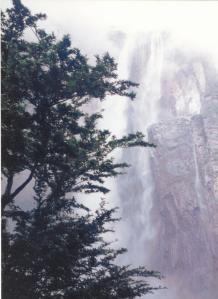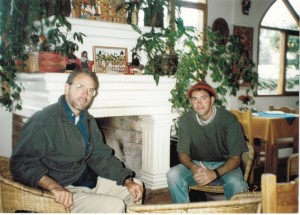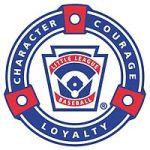Saturday, November 15, 1997 (11:34 am)
 I am sitting on a bench overlooking a fenced-in pond stocked with tropical wading birds. It is hot, so I sat in the shade. Yesterday morning when I got up to spend a couple of hours in my Boulder, Colorado office before I left, I had to shovel six inches of snow off the sidewalk.
I am sitting on a bench overlooking a fenced-in pond stocked with tropical wading birds. It is hot, so I sat in the shade. Yesterday morning when I got up to spend a couple of hours in my Boulder, Colorado office before I left, I had to shovel six inches of snow off the sidewalk.
I’m at the zoo in Santa Cruz, one of the ways I plan to spend the day here in Bolivia’s second largest city. I expected a raw, thrown together town in
the jungle. Instead, it is very clean and well-organized, situated in a verdant savanna. The zoo, a green oasis in the concrete city, is the best I have seen South America.I arrived here this morning, leaving Denver 17 hours ago. I feel pretty well, as I was able to get 4 to 5 hours of sleep on the leg from Miami to La Paz. Tim will be coming in on Lloyd Aero Boliviano this evening from Cochabamba. I will join his flight as it continues on for another two hours to Manaus, Brazil, in the heart of the Amazon! Between now and them, I will see the rest of the zoo, have a long lunch and perhaps visit a flea market. The only negative is that my 26 lb. pack/suitcase, which I dare not let out of my sight, gets heavier every time I pick it up.
Monday, November 17
 A lot has happened since my last entry. I never did make it to the flea market but rather spent most of the day at the zoo,
A lot has happened since my last entry. I never did make it to the flea market but rather spent most of the day at the zoo,
including taking a nap on the grass under a tree, I decided to return early to the airport but, just down the street, I came across a Canadian bar where I found some La Batt’s beer and English conversation. Tim’s plane came in at 7:30 p.m. and we just were able to extract his checked baggage in time to make the departing 8:15 p.m. flight to Manaus. On the flight Tim started to tell me about how he had to rush around at the last moment to obtain his entry visa for Brazil. This was quite interesting to me as I wasn’t aware of the need for one. I had no choice but to stay on the plane and try to get through passport control. pleading stupidity, which of course was just the case.
Well, even though we had a sympathetic officer who appeared to be willing to look the other way, someone else got involved who claimed she did not want “to take the responsibility” and I was denied entry. We had to get back on the airplane which was continuing on to Caracas. While the airline was obliged to give me free passage, I had to put more than $700 on a credit card so that Tim could accompany me. The ticket agent really tried to put it to me in charging that much, but I had the last laugh. That charge somehow never showed up in my bill, ha! All this occurred around midnight after a long day.
 We finally got to Caracas around 3:30 a.m. and took a taxi to a cheap hotel nearby. We awoke just before noon and, after stopping at the airport to cash money orders and to get out bearings, we took a taxi up the mountains to Caracas, which is situated 900 meters above sea level.
We finally got to Caracas around 3:30 a.m. and took a taxi to a cheap hotel nearby. We awoke just before noon and, after stopping at the airport to cash money orders and to get out bearings, we took a taxi up the mountains to Caracas, which is situated 900 meters above sea level.
We checked into the hotel Las Americas (Where I had stayed many years before when I first arrive in Venezuela with the Peace Corps in 1966) and spent the afternoon walking the Sabana Grande and eating a fine seafood meal. I am determined not to let this “change in plans” ruin the trip. We spent much of today, Monday, in a very disorganized travel agency attempting to arrange a trip to the Venezuelan Highland’s resort of Canaima, near Salto Angel. Also I am having difficulty making my cash card work in the appropriate machines here and have wandered all over in an attempt to cash travelers checks.
Tuesday, November 18
It’s 10:31 a.m. and I’m sitting next to Tim on an Avensa flight to Canaima. When we got to the Caracas Airport this morning, two hours before the flight as required, we were hustled into
signing up for a full-day boat/jeep tour from the camp to the base of Salto Angel. The cost was an additional $125 each, which seemed a little steep, but when are we going to get to this part of the world again?
Last night, after finally picking up the last part of our ticket package from the travel agency at 5:00 p.m. and finding a money exchange house to cash some money orders, we took the “Metro” to Plaza Bolivar. This is a more upscale part of Caracas and the statue of the “Libertador” astride a horse was impressive. There was an orchestra warming up when we arrived, so that we decided to take a long walk and return to their music. Unfortunately, even after an hour they still hadn’t started and, as were tired from the frustrations of the day, we took the Metro back to our station of Chacaito and turned in.
It is a small world. The Canaima lodge we have arrived at was founded by “Jungle Rudy,” a Dutchman whom I knew in Puerto Ordaz thirty years ago. In fact, he lived with me for a while when he was down on his luck. Ending up in the resort he founded was purely by chance. Also, one of the guides at the camp attended Fe y Alegria in Puerto Ordaz where I taught in the Peace Corps, although well after I had left. He tells me that the Sisters Teresa and Sacramento, two nuns that I knew, are still there.
We took an afternoon trip to Salto Sapo the first day. the waterfall was broad and we were able to walk behind it.
Today we were picked up at 5:15 a.m. for our trip up the river in a dugout canoe to Salto Angel. There were 16 total in our group
divided up into two boats. All the Venezuelans were excited about a professional baseball player, Omar Vizquel, and his wife being among us. The trip up river took most of the morning and we finished it off with a long hike through the jungle to the base of the world’s highest waterfall, 1005 meters. After the clouds finally parted, we were treated to a spectacular view. The day was memorable and goes a long way towards replacing that which we had expected from a visit to the Amazon.
Friday, November 21
Tim and I are sitting in an English pub called La Reina Victoria in Quito, Ecuador. Yesterday we left Canaima at noon and spent the day traveling to Quito where we arrived at 9:30 p.m. We took a taxi to the hotel Real Audiencia in the Centro Colonial of the city. We spent this morning on a walking tour through that part of town where they have attempted to maintain the original building facades and character of the early XVII century. As we could find no place to exchange travelers checks or a travel agency to purchase tickets for our planned flight to the coast, we took a cab to the “new city.”
This part of town is much more modern, with a lot of European-looking faces on the street. However, we were well reminded that we are still in Latin American as it took one-half day to organize our airplane tickets through an agency, and then we really didn’t get what we had been promised. The Quitenos are very friendly and the city, which almost strides the equator at 9,300′, has a pleasant climate with green hillsides and palm trees in the city plazas. Lots of cars, and of course, lots of evidence of poverty, but overall, the inhabitants appear healthy and happy, with a fairly good level of prosperity.
Sunday, November 23
Yesterday morning Tim and I got up, checked out of the hotel and took a taxi up to the tortured looking statue of the Virgin on Panecillo. This “sugar lump” hill gives a wonderful panoramic view of much of Quito.
Just after mid-day we flew from Quito to Guayaquil on the coast and Ecuador’s largest city. We then took a bus about 110 K’s north to the fishing village/resort area of Playas. The heat and humidity of this place is overwhelming.
After checking into a mid-level Las Redes Hotel, we walked the beach, which was populated by late day bathers and a long row of fishing boats. Our room was sweltering last night and while trying to let in some cool air we just invited in a mosquito party. Today we moved to a better hotel, El Tucano, and got a room with air conditioning. We now sit beside the pool, reading and contemplating what to do with the rest of the day.
Monday, November 24, 1997
We decided to leave Playas early. However , it rained all last night (El Nino) and we were afraid the bus would not be able to make it back to
Guayaquil. We saw a number of flooded out homes and intersections with more than a foot of water. Eventually we made it to the airport just to find the whole place flooded with everyone who could perched on any elevated surface.
Tuesday, November 25
By good luck we were able to exchange our Quito return tickets on SAETA, which was closed down, for TAME which still had occasional flights. We arrived mid-day to a drier, yet very overcast, Quito. A very friendly taxi driver took us up the central valley to the indian arts and crafts town of Otavalo about 100 K’s north.
The driver talked to us of history, current politics and took several side trips to show us sites of interest. We looked at several hotels in Otavalo and decided upon the Ali Shungu, which was highly praised in the Lonely Planet guidebook. We especially like gathering around the fireplace. We find this pueblo very charming with friendly Indians who still wear their region’s costumes on a daily basis. Everything possible to be made of wool is for sale. Quality is good and prices are very low.

A favorite photo. Notice the “LATITUD 0′ 0′ 0′ ” banner in the background, we’re standing on the equator with my pant legs still wet from being in the Guayaquil airport on the coast hours before.
Thursday, November 27 (Thanksgiving)
Tim and I are sitting on bus in Otavalo’s “Terminal Terrestre” waiting for it to fill up so that we can leave for Quito. We have spent these past few days relaxing in this pleasant town.
Disappointingly, we continue to suffer from the effects of “El Nino,” as we have been unable to see the surrounding, snow-covered volcanoes due to the cloud cover.
The quality of goods sold here by the Indian cooperatives is outstanding. You can buy the heavy white wool sweaters. so evident in Ireland, for around $6.00! Tim purchased several items as gifts for his Bolivian Friends and a Fedora hat to complete his traditional dance outfit. I bought several small paintings, some shawls and two sweaters.
We arrived in Quito around mid-day and took a room at the San Sebastian Hotel. This is a first-class facility with all the amenities, so that we were able to enjoy a traditional American Thanksgiving afternoon, watching the Dallas Cowboys play football. This evening, after a feint-hearted attempt at finding a traditional turkey dinner, we went to Las Redes restaurant and had a magnificent shellfish feast.
Friday, November 28, 1997
I’m on my way to Miami and then home. Unfortunately, one leg of Tim’s scheduled return flight had been canceled, so he had to spend another day in Quito. This was quite upsetting to him, as tomorrow is the first day of a weekend fiesta in Tarata that he “could not miss.” He is part of a dance group and doesn’t want them to feel he puts traveling above participating with them. Additionally, he has invited friends down for the event.
I was sad to leave him and sadder still to see him so disappointed in not being able to meet his obligations. However, all in all, it was quite an adventure and a pleasure to spend two weeks with my son.
























